
"Your source for standard gauge modeling in 1:20.3"
|
|
|
"Your source for standard gauge modeling in 1:20.3" |
|
|
|
Future Steam (The Locomotives That Dave Would Like To Build) Since I began tinkering with standard gauge modeling in 1:20.3 scale, I've had a short list of locomotives which I hope one day to build. These are reflective of my own peculiar interests in the late steam era, and in particular, those locomotives which were either highly efficient, innovative, or showed the unique styling of industrial designers such as Raymond Lowey--in other words, high horsepower locomotives with an Art Deco appearance. The Pennsy experimental and duplex drive locomotives top this list as do the rugged, efficient locomotives of the Norfolk & Western. I am also a fan of the Southern Railway, largely because it ran through my home town, and my first encounters with steam as a boyish railfan were due to the good offices of the Southern steam program--God bless the Claytor brothers and may they rest in Glory. The locomotives below are presented in no particular order of how or when I intend to construct them. I have simply grouped them by road. A few of their components I have already made: axles and 70" driver tyres for the "A" and the "J" for instance, N&W blueprints for the latter. If you are as much a fan of any one of these locomotives as I am, then drop me a note here. It would be a delight to build some locomotives together! |
| The Pennsy
Experimentals: Art Deco Takes To The Rails In the late 1930s and early 40s, each of the three major commercial locomotive builders had a distinctive approach to building the next generation of steam locomotive. Lima Locomotive Works, for instance, continued to advocate their "Super Power" concept: Increased boiler horsepower, coupled with various thermal efficiency devices, necessitating even larger fireboxes and the trailing trucks necessary to support them (such as in the Allegany 2-6-6-6 or the proposed 4-8-6). Baldwin had its "duplex" drive concept: two sets of non-articulated running gear mounted in a rigid frame powered by the same boiler. The advantage of the duplex concept was better steam distribution between four cylinders, rather than two; correspondingly smaller and hence lighter alloy main and side rods, resulting in reduced reciprocating weight and thusly reducing dynamic augment (hammer blows to the track due to unbalanced reciprocating forces). The final concept was that of applying the steam turbine to a locomotive, either indirectly through a generator and traction motors (a power plant on wheels) or directly through reduction gears. |
 S1
6-4-4-6 Duplex
(1939) S1
6-4-4-6 Duplex
(1939)Baldwin had kicked around the idea of building a demonstrator duplex, but then the Pennsylvania Railroad beat them to the punch with this, the "Big Engine" as it came to be called. Designed by Baldwin but built by the Pennsy at Altoona, for nearly two years the Raymond Lowey streamlined S1 6-4-4-6, nearly 140' long, was displayed, under steam on a treadmill at the 1939 World's Fair in New York. When the S1 finally hit the rails in passenger service, there was nothing else like her: Exceptionally fast with 84" drivers and tremendous horsepower. There are unverified stories of the S1 topping out at over 140 miles per hour; in which case, she, rather than that dinky Gresley A4 Pacific type Mallard holds the world speed record for reciprocating steam. The S1 was something of a flop however: Too rigid to enter the curve into Harrisburg, PA station; and slippery when starting, by 1949 she was on the scrap line. |
 T1
4-4-4-4 Duplex (1942) T1
4-4-4-4 Duplex (1942) Baldwin's idea for a
duplex demonstrator was a scaled down version of the S1, with a
4-4-4-4 wheel arrangement (see thumbnail, at right). When the Pennsy contracted with Baldwin
to build a duplex drive passenger loco for Lines West application,
and hence avoid one of the major design errors of the mammoth S1,
the T1 4-4-4-4 was the result. The first two T1's were essentially
the Baldwin design but with two notable outward changes: the
application of Franklin Type A poppet valve gear and Raymond Lowey's
distinctive, fully skirted "shark-nose" streamlining. Painted in Pennsy's nearly black Brunswick Green, the first two T1s were a
striking sight to behold. With 80" drivers making them capable of
120 mph out on the road, their performance on the test stand was
exceptional. Pennsy was aiming for a steam equivalent to the
immensely successful GG1 electric, but the 50 production models which followed the initial
two locomotives did not live up to either Pennsy or Baldwin's
expectations for a number of reasons, and they were retired early,
though the subsequent bad press given the T1 is, by those who knew
and ran them, unwarranted. Baldwin's idea for a
duplex demonstrator was a scaled down version of the S1, with a
4-4-4-4 wheel arrangement (see thumbnail, at right). When the Pennsy contracted with Baldwin
to build a duplex drive passenger loco for Lines West application,
and hence avoid one of the major design errors of the mammoth S1,
the T1 4-4-4-4 was the result. The first two T1's were essentially
the Baldwin design but with two notable outward changes: the
application of Franklin Type A poppet valve gear and Raymond Lowey's
distinctive, fully skirted "shark-nose" streamlining. Painted in Pennsy's nearly black Brunswick Green, the first two T1s were a
striking sight to behold. With 80" drivers making them capable of
120 mph out on the road, their performance on the test stand was
exceptional. Pennsy was aiming for a steam equivalent to the
immensely successful GG1 electric, but the 50 production models which followed the initial
two locomotives did not live up to either Pennsy or Baldwin's
expectations for a number of reasons, and they were retired early,
though the subsequent bad press given the T1 is, by those who knew
and ran them, unwarranted. |
|
|
|
Q1 4-6-4-4 (1942)
|
|
Q2 4-4-6-4 (1944-45)
|
 S2
6-8-6 Direct-Drive
Steam Turbine (1944) S2
6-8-6 Direct-Drive
Steam Turbine (1944)An Englishman, Sir Charles Parsons, was the inventor of the steam turbine in the late 19th century. Ever since it's introduction to naval vessels and to power plants, locomotive designers had sought to apply the thermally much more efficient turbine to the problem of moving a locomotive. In Europe during the teens and twenties, several attempts were made to construct a successful indirect drive steam turbine electric locomotive. In the mid-1930s the LMS in England built a semi-successful direct drive turbine locomotive along the lines of a Coronation class 4-6-2 (for more on the European experiments, see the superb website Loco Locomotives). The Pennsylvania Railroad's contribution to turbine design was to build a direct drive turbine locomotive whose 68" drivers would be at home powering either freight or passenger trains. 6-wheel lead and trailing trucks were not in the original design (a 4-8-4) but were necessitated by wartime shortages of lightweight alloy steels. The S2, though capable of handling heavy 1000 ton trains at 100 mph and completely free of unbalanced reciprocating forces, was a ultimately a flop because of excess steam usage at low speeds, causing boiler pressure to visibly plummet. She was withdrawn by 1949. |
|
N&W: The Citadel of Steam Steam's last stand is the story of the Norfolk & Western who did not put out the fires in their last mallet articulateds until May of 1960. There is good reason why steam survived so long on the Norfolk & Western: (1) The N&W was overwhelmingly a coal hauling road and only secondarily a bridge freight route (2) the N&W devoted considerable company resources to developing and building their own locomotives in their Roanoke, Virginia shops. N&W's in-house steam designers were second to none. They took the best ideas of Baldwin, Lima and Alco, discarded the dross, and focused upon one task: purpose built steam designed for high availability & low maintenance with respect to the peculiar operating characteristics of the saw tooth profile of the N&W. Their result: three major classes of purpose driven steam: The A class simple articulated 2-6-6-4 for hotshot time freights, The Y6 class mallet articulated 2-8-8-2 for mountain slogging and helper work, and the Cadillac of passenger steam, the J class 4-8-4. In supporting roles were a gamut of USRA design 4-8-2s, 2-6-6-2s and 0-8-0s, turn of the century M-Class 4-8-0s, 2-8-0s and 4-6-2s for branch line work. |
.jpg)  J
Class
4-8-4 #611 J
Class
4-8-4 #611I never got to ride behind the "J" as the #611 is known to her fans, but I saw her as a boy in the museum in Roanoke just a few years before Norfolk Southern restored her to operation. The J is the best all-around 4-8-4 steam locomotive ever built in the USA. Better than a T1, better than a UP FEF-3, and better than a Daylight. Why? Better tractive effort, capable of 100+ mph running, all roller bearings, and designed with an eye towards low maintenance. Beat that Lima & Alco! The J may also have the most sensible streamlining ever applied to a steam locomotive since all its major parts are accessible for maintenance. Anyone want to build one? |
.jpg) A
Class 2-6-6-4 #1218 A
Class 2-6-6-4 #1218I only got to ride behind restored A Class 1218 once, though I chased it on several occasions. The A was the Norfolk & Western's answer to Super Power. The first one was design and built during the height of the great Depression (1936), the last in the early 1950s, complete with roller bearings on all axles, side & main rods. The A's were at home on hotshot freights but could also pitch-hit at 70 miles per hour on passenger runs. They were a common site on the N&W mainlines from Tidewater Virginia through the mid-west into Ohio. One was even lent to the Pennsylvania Railroad in the early 40s for testing as a possible candidate for reproduction on that articulated wary giant. As WWII traffic levels shot upward, the Pennsy opted for copies of the C&O's Van Swearingen 2-10-4s as well as developing their own home grown freight duplex, the one-of-a-kind Q1 4-6-4-2 and the Q2 4-4-6-2 which did go into production (one prototype plus 26 units). |
.jpg) Y6b 2-8-8-2
(1948) Y6b 2-8-8-2
(1948)The Norfolk & Western Y6b was the ultimate development of the Mallet compound articulated. In its lineage is the USRA 2-8-8-2, itself based upon an Alco design delivered to the N&W on the eve of US involvement in WWI, but far surpassing the USRA locomotive in power, speed and efficiency. The Y6 class developed its greatest power around 25 mph since it was intended for heavy coal haulage in mountainous territory, not for open ground running. Even so, the Y6, with its diminutive 58" drivers, was capable of making around 50 mph if in a hurry, though crews reported it sounded as if the rods were about to fall off. Two Y class locomotives have been preserved, a Y3 and a Y6a, the latter of which almost made it into the Norfolk Southern steam program. Two Y6bs survived into the mid 1970s but were scrapped by their owner. |
|
The N&W operated two main classes of 4-8-0 (variously known on other roads as a "Twelve-Wheeler" or "Mastodon" but on the N&W as a "Mollie"). The smallest and oldest of these was the M Class. Built in 1906, the Mollies were the mainstays of the Blacksburg and Abingdon Branches. Their small 56" drivers and light axle loading made them particularly suitable for this work. One example of this odd wheel arrangement remains in service at the Strasberg Railroad in Pennsylvania, the other is under cover in Abingdon. The Mollies were immortalized by O. Winston Link's Abingdon Branch photography and audio recordings from the mid-1950s. Their distinctive three chime whistle contrasted markedly with the usual single chime "hooter" of other N&W freight locomotives. |
 The
Great Steam Show: Southern Railway in the 70s The
Great Steam Show: Southern Railway in the 70sAfter the end of the Reading Rambles, where did a boy go to see steam in the 1970s? Why to the deep South and to steam excursion program of the Southern Railway. When Dr. Pail Merriman purchased the 4501 from the Kentucky & Tennessee Railway in 1966, and to everyone's surprise, Southern Railway iconic president D. W Brosnan okayed a ferry move by the locomotive down the reconstructed "Rat Hole" division to Chattanooga, nearly 30 years of excursion fun and top notch public relations was being inaugurate by the Southern and its successor, Norfolk Southern. With the Claytor brothers, W. Graham and Robert in control, the Southern steam progam stabled a remarkable cast of locomotives, many of whom were non-Southern hired guns since most SR steam had been cut up during dieselization. The parade ended in 1994 shortly after the passing of Robert Claytor, who had overseen the nadir of the steam program: the restoration of the N&W J and A above (if only he could have gotten that Y6!). |
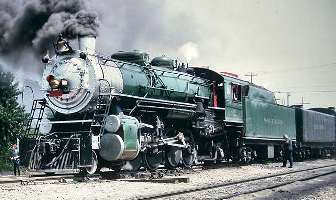 Ms Class 2-8-2 #4501 Ms Class 2-8-2 #4501Here is the first steam locomotive I ever road behind: Southern Railway Ms class 2-8-2 #4501. It was the summer of 1975 on a trip from Asheville, NC back to my home town on Knoxville, and I was hooked! 4501 was the second member of the first class of mikado owned by the Southern (1911). She was a simple locomotive: no feedwater heater, automatic stoker, coal pusher, or any other efficiency devices to break down. And that lovely whistle. Sometimes it was Master Mechanic Bill Purdie's own, sometimes a Southern 3 chime long bell off a scrapped Ps-4 pacific, but what ever the case, I will always remember her as the engine which rocked me to sleep as a seven year old boy. |
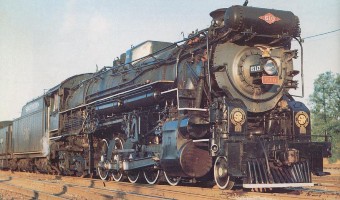 ex-Texas & Pacific 2-10-4 #610 ex-Texas & Pacific 2-10-4 #610The first two excursions I went on were powered by the 4501. But in 1978 a substitute appeared, Texas & Pacific texas type #610, fresh off it duties hauling the American Freedom Train (in where else, Texas of course). The 610 is an oil burner and an example of Lima's first generation of Super Power: In essence, it's really a stretched Boston & Albany A1 Berkshire, but with an extra driver, complete with that odd articulated trailing truck which made the A1s tricky to backup. When I first saw the 610 pull into Knoxville's Southern Railway station, I was shook, literally by the weight of its poorly balanced counterweights. Those are big rods for little 63" drivers to try to counter-balance! By the 610 had a whistle which I still find haunting in the several tape recordings an old Southern Railway conductor made for me. The late Jim Bistline, the general manager of the Southern and later NS steam program, once remarked that there was nothing which they couldn't put behind her that the 610 could not pull (22 or 23 coaches on one occasion). She's still around, in semi-operable condition at the Texas State Railroad in Palestine, Texas. Maybe we'll see her run again one day. Here's to you, grand lady 610! |
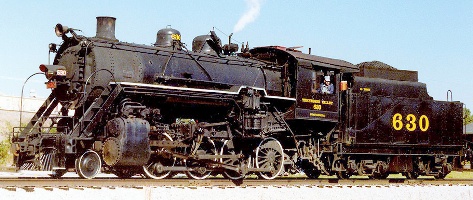 Ks-1 Class 2-8-0s #630 & #722 Ks-1 Class 2-8-0s #630 & #722
Like 4501 which was sold to an
Appalachian shortline as the Southern dieselized, to sister
consolidations, former veterans of the Murphy Branch in western
North Carolina, were sold to the standard gauge remnants of the ET&WNC
(a.k.a. "Tweetsie"). These two consolidations were then bought back
by the Southern during the early years of its steam program in the
60s, and when last operated together in the early 80s were leased to the
Tennessee Valley Railroad Museum (TVRM) in Chattanooga. Since that time, the 722 is back on the former Murphy branch,
dismantled and awaiting restoration by the Great Smokey Mountains
Railroad. The 630 is now owned by the TVRM and after undergoing a ground-up restoration
is back in steam as of 2011. Both engines
(1906 products) are unique in that they were originally slide slide
valve
|
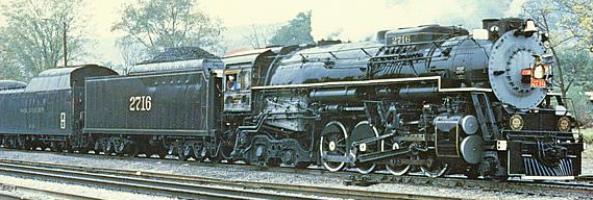 ex-C&O
Kanawha 2-8-4 #2716 ex-C&O
Kanawha 2-8-4 #2716Now here's a what if for you: What is Southern had not dieselized so soon, and what if Southern had gotten the Super Power bug in the 30s as so many other railroads did, and what if they had signed a contract with Lima for a "super-mikado": a van Swearingen second generation Berkshire (which of course no road in Dixie would ever call one of their locomotives by so disagreeable a name). And what it these 2-8-4s entered into revenue service, were "Southernized," and what if one survived to enter into the Excursion Program? Well, 2716 is the answer. And it is a lovely what-if. Powerful, graceful, and with a lovely Southern 3 chime long bell mounted to her in liee of that C&O multi-chime thing. I never saw her in steam for that one year (1980), but I did hear her wail at least once one Sunday morning as she headed an excursion out of Knoxville. |
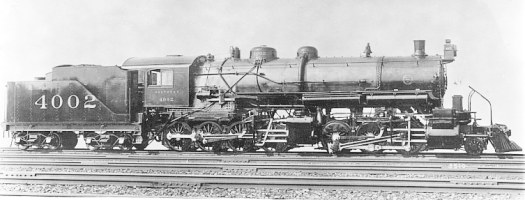 Ls Class 2-6-8-0 Ls Class 2-6-8-0Okay, this was not an excursion engine, but it just strikes my fancy. The Southern's initial forays into the world of mallets prior to World War I were three asymmetrical compounds with the unique wheel arrangement of 2-6-8-0. The 4001 and 4001 were bought for the saw tooth profile of the Virginia Southwestern Railway, a SR predecessor running from Appalachian, Virginia to Mound City, Tennessee. The 6399 was inherited from a merger with the Alabama Great Southern. The locomotives in their careers migrated to the Knoxville strict and to helper work on Saluda grade in western North Carolina. They were scrapped in the late 1930s. Only the Great Northern had locomotives of the same odd wheel arrangement in North American; and in Europe, only the wartime Reichsbahn was in the process of building a modernized version of the Ls as a simple articulated before the sole prototype, barely a chassis, was destroyed or dismantled at the Borsig factory in Berlin. |
| The Phantom Locomotives |
.jpg) The
Duplexes That Never Were The
Duplexes That Never WereOkay, here's the scenario: The Penn-Central merger happens back in the 30s, and Henry Dreyfus gets hired to streamline the first Penn-Central T1, and then they last into the 1960s . . .
|
| The Garratts That Never Were To my mind, one of the oddities in the development of the steam locomotive in North America was the total lack of any representative from that ubiquitous class of articulated locomotive in Asia and Africa: the Garratt. Where were the North American Garratts? They are superior to the mallet compound articulated or the single expansion simple articulated in several respects: (1) superior flexibility on curves (no boiler hanging over the front power unit), boiler is slung between the engines so that maximum thermal efficiency can be obtained from the boiler since it can be as fat and deep as the loading gauge will allow, (3) fireboxes are readily accessible since no running gear are supporting them, (4) boiler swing to the inside of a curve, creating greater stability when entering a curve, (4) both power units can be identical, and hence, easily interchanged saving on maintenance costs, (5) Garratts can use their coal and water supplies for adhesion, not dragging them along as excess and wasteful baggage. So again, why no North American Garratts? Was it just because they were predominantly used by the Commonwealth? Was it a nescient Anglo-American rivalry? Alco did at least have the North American rights from Beyer-Peacock to build them.
Well, here's my suggestion for the North American Garratt that never was built. And it is the Beyer-Peacock "Super-Garratt" pictured at the top of the page, which was a serious proposal, just never built. The Super Garratt or Quadruplex was in fact a combining of the Garratt and mallet concepts in order to produce a highly efficient normally aspirated steamer, which would put tremendous tractive effort at the hands of just one crew. Imagine: a modern locomotive which would have actually surpassed the tractive effort and potential of the Erie and Virginian Triplexes, the equivalent of maybe two N&W Y6s in combination! Wow! Maybe someone will do it in live steam one day. |
Last update: 20 August 2013
| Copyright 2004-2009 CumberlandModelEngineering.com. All Rights Reserved |